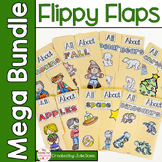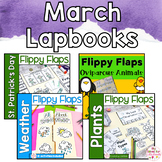Weather Kindergarten Science Project Unit w/ Craft Chart Journal Tools Activity
- PDF
What educators are saying
Also included in
- This ENTIRE YEAR of Science and Social Studies Kindergarten Interactive Notebook and Lapbook Activities goes beyond just a worksheet. Filled with lots of fun flips and flaps to make and various hands-on activities, your students will be engaged and learn about themes in many different ways and willPrice $142.00Original Price $202.00Save $60.00
- Your students will love learning all about Weather with this printable and digital interactive notebook using Google Slides! This is a fun, interactive activity that can be incorporated into your Kindergarten or 1st Grade science lessons using Google Classrooms or simply printed and made into a lapbPrice $7.50Original Price $10.00Save $2.50
- Your Kindergarten students will have so much fun this March exploring and learning about different holidays and themes with these hands-on, interactive lapbooks! These Science interactive notebooks go beyond just a worksheet, with lots of fun flips and flaps to make, and various activities, your stuPrice $16.00Original Price $20.00Save $4.00
Description
Make weather research fun for kindergarteners! Turn your students into meterologists as they research weather and learn weather facts through this hands-on, science interactive notebook!
When it’s time to teach different types of weather to kindergarteners there’s one thing we all know it must be: FUN.
But let’s not stop at just FUN.
These weather research activities can give you peace of mind knowing that you can use these weather research activities all week long! No need to go hunting for anything else weather themed.
This weather research activity goes beyond just a worksheet, with lots of fun weather flips and flaps to make, and various interactive weather activities.
Your meterologists will be engaged and learn about weather in many different ways and will have a keepsake lapbook to bring home and share with their families!
***Click here for the digital version***
What weather activities are included:
☼ All About Weather - research different types of weathers with this mini flip book
☼ Weather Word / Picture Match – learn different weather vocabulary by matching the picture to the vocabulary word
☼ Weather KWL – tap into the students’ prior knowledge and schema while also figuring out what they want to learn during the weather unit
☼ Clouds can/have/are – students create a mini anchor chart to describe clouds
☼ Meteorologists study/use/can – learn all about the people that help predict the weather each day
☼ Describe the Weather – students will use various adjectives to describe different types of weather
☼ Weather Facts – document student learning by recording interesting facts throughout the unit
☼ Draw Weekly Weather – Record the weekly weather in this weather chart
☼ Weather Vocabulary – students will discover new weather words
☼ Make a Cloud using cotton balls – a fun weather craft to describe clouds
☼ My favorite type of weather is... writing prompt – Get students writing all about their favorite weather
☼ Weather Tools – ever wonder what tools people use to measure and determine weather? Come find out!
☼ Compare Sunny/Snowy – use a Venn Diagram to compare various types of weather
☼ Compare Rainy/Sunny - use a Venn Diagram to compare various types of weather
☼ Compare Snowy/Rainy - use a Venn Diagram to compare various types of weather
☼ Favorite Weather Book – pair this with your favorite weather book
☼ Graph the Weather – Compare the type of weather your students experience all week long
☼ and more
What do I still need?
☆ file folder, construction paper, or notebook
☆ scissors
☆ glue
☆ markers, crayons, or colored pencils
That is it!
How can this be used?
This resource can be used in many different ways.
You can have your students create a lapbook from a file folder so they have a keepsake to bring home.
Students can also use these activities in an interactive notebook and keep them throughout the school year.
Please use this as it best fits your classroom and your students.
This is a great way for your kids to be engaged in learning about weather! If you have any questions please let me know! Hope you and your students have a great time exploring different types of weather!
If you like this Flippy Flap, check out my other themed Flippy Flaps Click to view more Flippy Flaps
*******************************************************************
Thank you for purchasing, downloading, browsing, following and inspiring! I hope this brings your students excitement and makes your job a little easier! If you find anything in this packet that needs to be reworked or might work better for your students, please let me know and I will be happy to rework any activity/packet that you have purchased to fit your needs.
Let's Connect
Big Ideas For Little Hands Blog
Big Ideas For Little Hands Facebook
Big Ideas For Little Hands Instagram
Big Ideas For Little Hands Pinterest
FEEDBACK
I truly appreciate feedback. It helps me decide which products are most helpful and valuable for your students. The feedback you provide helps me make my products better to suit your needs. I Love to create so if there is anything that you might need or want to make your job easier, just let me know!
To Earn Credit for Future Purchases,
Go to My Purchases page (you may need to login). Beside each purchase you'll see a Provide Feedback Link. Click it and you will be taken to a page where you can give a quick rating and leave a short comment about the product. Why is feedback so important? Each time you give feedback, you earn TPT credits that you can use to lower the cost of your future purchases.
Become a Follower
If you would like to be the first to know about my new discounts, freebies and product launches, click the GREEN STAR next to my shop logo on my main page and you will become a follower. This action will now send you email updates about this store. If you have any questions, be sure to contact me!
Enjoy! Julie
© Copyright 2018 Julie Davis Big Ideas For Little Hands
All rights reserved by author. This product is to be used by the original purchaser only. Copying for more than one teacher or classroom, or for an entire department, school, or school system is prohibited. This product may not be distributed or displayed digitally for public view, uploaded to school or district websites, distributed via email, or submitted to file sharing sites. Failure to comply is a copyright infringement and a violation of the Digital Millennium Copyright Act (DMCA). Intended for single classroom and personal use only.








